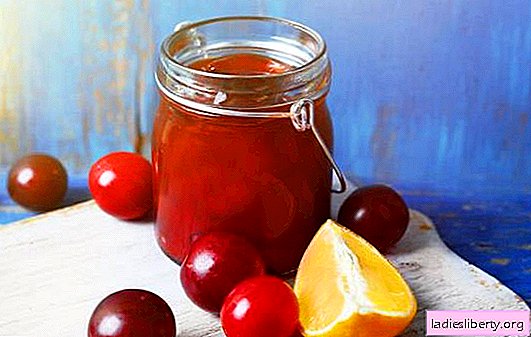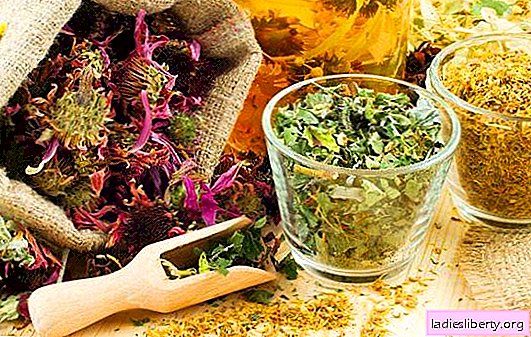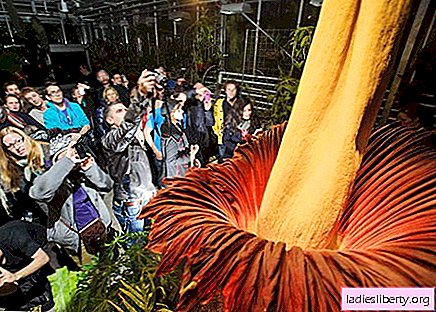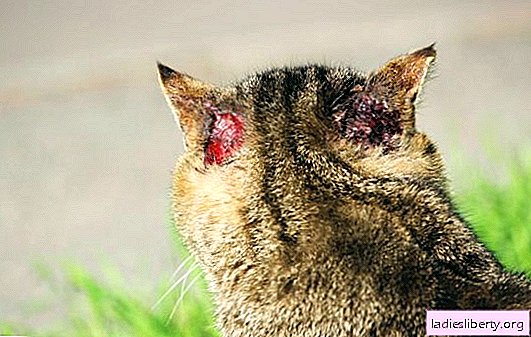
In nature, the ripening time of oranges and plums occurs at different times.
Orange is a tropical fruit and the season of its mass gathering begins immediately after the end of the ripening period of a plum - a “resident” of temperate latitudes.
But due to the high yield of citrus fruits and excellent properties that allow long-term storage of crops, they are abundant in our supermarkets all year round.
It is not known to whom the idea belongs, to cook jam from plums with orange for the winter, but this person is not without taste, because plum goes well with citruses.
These two fruits even have spicy spices that can both serve as excellent companions, for example, vanilla and cinnamon - the most commonly used combinations in the preparation of desserts and drinks based on oranges and plums.
As for the technology of cooking jam, this process, in general terms, is understandable to everyone, but many women often cook without thinking about the physical and chemical laws that people use at home constantly, and the success of culinary skills depends on an understanding of the processes that occur during mechanical and heat treatment of products.
In cooking, little things do not happen, as in any science. Biology, chemistry, and physics are closely connected with it. If you want to achieve success in the culinary business, often remember the natural sciences, because understanding their laws will help to cook jam and prepare any dish without errors, on the first try.
Plum jam with orange - basic technological principles
A puree mass of fruits and sugar is jam, and jam is pieces of fruit in syrup. The technology of cooking jam is a tradition of Slavic cuisine. Note that as long as sugar was an expensive and hard-to-reach product, jam was cooked on honey. This information is for those who want to know the taste of a real Old Russian dessert.
At first glance, cooking jam does not present any difficulties, but not every housewife succeeds in preparing whole slices or slices in transparent syrup. Sometimes, instead of jam, it turns out a sweet puree mass - tasty, but it does not look so tempting.
How to get beautiful, whole slices in jam from plums with orange?
Many housewives use the method of boiling fruits repeatedly in their own juice, after sprinkling them with sugar, this is the so-called five-minute jam. This method is quite suitable when the fruits are of sufficient density so as not to boil already in the first stage. Too dense fruits, poorly secreting juice, dissolve sugar for too long.
The next cooking method involves the preliminary preparation of sugar syrup, in which the fruits are dipped and boiled until the fruit juice is combined with the syrup. This stage should be taken with maximum attention, and even take a scientific approach, remembering what is the diffusion of liquids, their density. The quality of the prepared jam depends on how high the sugar concentration is in the syrup and in the extracellular juice.
According to the laws of physics, a dense liquid (syrup), penetrating a less dense medium (cellular juice in fruits), displaces it, completely replacing itself. This process is promoted by an increase in temperature. Sugar displaces fluid from the cell, which passes into the intercellular space of the fetus. Ideally, it is necessary that the sugar penetrates into the cell faster, and the intercellular juice simultaneously enters the intercellular space a little slower to ensure the normal density of the fetus, in a ratio of 1: 1.
At a temperature of 100 degrees, the intracellular juice boils, which creates an obstacle to the penetration of sugar into the cell, but as a result, after cooling, moisture is lost, leaving the steam. A vacuum is created inside the fetus and its cells, which draws in sugar. Therefore, it is necessary to alternate cooking and cooling to create a vacuum effect. Cooking should proceed at a temperature close to the boiling juice. Fruits should be lowered into syrup, heated to 80-85 ° C - the temperature difference will contribute to the rapid replacement of juice in the intercellular space.
There is one more nuance to which you should pay attention: for almost all varieties of plums, the sugar concentration in the syrup should be 25-40%, and for citrus fruits - 70-75%. In this case, the fastest and most convenient way is to find the arithmetic mean ratio, that is, we summarize two indicators and divide the value into two. We get the amount of sugar per kilogram of prepared raw materials - 52.5%, that is - 525 g.
Other technical details - preparation of hot and dry sterile containers, hot pouring of prepared jam from plums with orange, immediate corking and wrapping cans of jam - are familiar to every housewife, so we proceed to prepare jam from plums with citrus notes.
Recipe 1. Plum jam with orange juice and zest
Composition:
Plums "Reclod" 1 kg
Oranges 4-5 pcs.
Sugar 1,150 kg
Cooking:
We prepare oranges: with washed fruits we cut off the skin with a sharp knife, being careful not to touch the white part under a thin orange layer. You can remove the peel on a grater, but a thin and long straw from orange zest will look prettier in a jar of jam from plums with orange for the winter.
To prepare sugar syrup, we use the juice of oranges, from which the zest is removed. The syrup must be thick, so the juice and sugar are cooked in a ratio of 50/50. From one kilogram of oranges you can get 750-800 ml of juice, so 1.35 kg of juicy citrus fruits will be needed for a syrup of 1,150 kg of sugar. Boil the syrup from sugar and orange juice to reduce by 1/3. Let cool a little and immerse prepared slices of plums in it.
We select dense plums, remove the stalks. For a couple of hours, leave them in a strong soda solution. Industrial canning uses a more active solution of caustic soda, but, in order to avoid injuries and burns, do not give in to such a temptation. Soda, as a solvent for fat, removes plaque of essential oils from the surface of the fruit, drying the plum skin, and this, in turn, leads to the expansion of pores and facilitates easier penetration of sugar into the pulp of the fruit. Baking soda acts the same as caustic, but a little slower, but safer. After a soda bath, carefully wash the plums, cut in half and remove the seeds. We bring the plums to a boil 2-3 times, but do not boil in the finished orange syrup. At the last cooking, add the orange zest.
Recipe 2. Oven plum jam in the oven
Composition:
Orange slices, peeled 0.5 kg
Plum "Ugorka" 500 g
Sugar 0.525 kg
Cooking method:
Prepared slices of oranges and plums (the process of preparing plums is in recipe No. 1) with a needle and fold them into a heat-resistant dish with non-stick coating, pouring each layer with sugar. Cover and place in a cool place. When the juice comes out noticeably, put the pan without the lid in a preheated oven (200-220 ° C) and let the jam stand until it boils. Then remove the container and dip it into the prepared basin with ice water. Gently mix the syrup, trying not to mash the berries, and put the dishes back in the oven. Perform this operation three times. The third time, bringing the syrup to a boil, turn off the oven, and cover the jam with a lid, and do not take out until it cools down. Pack cold in sterile jars, sprinkling a surface with a layer of sugar. Put parchment under the lid, close it tightly and store in the pantry.
Recipe 3. Jam from plums with orange for the winter, on honey
Composition:
Cherry plum, yellow 1.5 kg
Orange juice 750 ml
Honey 0.5 kg
Cooking:
Sort ripe cherry plum and wash, and then blanch in boiling water for up to five minutes, and transfer immediately to cold water. Cut the berries into halves, remove the seeds.
Bring the orange juice to a boil and put honey (buckwheat) in it. Remove foam until transparent. Then immerse the berries for 10 minutes. Pour jam into hot jars immediately and seal.
Recipe 4. "Boteks" for fruit - plum jam with orange
Composition:
Orange Syrup 0.5 L
Plum honey (yellow) 1.0 kg
Cooking:
Sort out the plums and wash. Put them on a flat dish in one layer and freeze. In the meantime, boil the syrup from equal amounts of sugar and orange juice. Boil the syrup and the samples “on a thin string”, then separate 300-350 ml of syrup, and continue to boil the rest, reducing its volume by 30%. Thick syrup, at a temperature of 45-50 ° C, draw into a medical syringe and chop them with frozen plums with a bone, folding them into a pan with thick syrup. Let stand until the temperature is equalized, and then boil to 95-98 ° C, and immediately cork. Place parchment paper under the covers.
Recipe 5. "Dry jam" from plums with orange for the winter
Composition:
Oranges 1 kg
Plums (large) 1.4 kg
Vanilla 5 g
Sugar 1.2 kg
Water 1.0 L
Cooking:
Cook a very thick syrup by adding vanilla. Prepare oranges, cut them into slices. Cool the syrup to 80-85 ° C, and put the orange slices in it for 10 minutes. Then remove from the stove and wait until it cools completely. On a sheet covered with foil, put the slices in one layer and dry in a preheated oven at 40 ° C.
Prepare plums: sort them, blanch for 5 minutes in boiling water, then dip in cold water and, after cooling, cut into slices, removing the seeds. Preheat the syrup in which the oranges were boiled, put plums in it, cook until it boils. Just like slices of oranges, dry in the oven.
Put dried fruit in jars, sprinkled with sugar, and store at room temperature without moisture.
Recipe 6. Caucasian jam from plums with orange for the winter
Composition:
Ginger, grated 20 g
Cinnamon 2 g
Walnut (kernels, peeled) 100 g
Plum Hungarian or Greengage 1 kg
Orange zest 50 g
Orange slices 1.2 kg
Water 1 L
Sugar 1.3 kg
Cooking:
Prepare the fruits: remove the seeds from the plums, remove the zest from the oranges, cut it into thin strips, and pierce the peeled slices with a wooden toothpick in several places. In a thick syrup, dip the plums first, and then the orange slices. Bring to a boil and cool sharply by placing a pan of jam in a bowl of ice water. Warm again to a temperature close to boiling, add zest, ginger, cinnamon and nuts. Stir and remove from the stove. Pack in hot cans and store in a cool place.
Plum Jam with Orange - Useful Tips and Tricks
Cook the jam, stirring it and removing the foam, only with a wooden spoon or spatula. Metal spoons affect the color of the fruit.
To preserve the jam, add citric acid to the syrup, one teaspoon per kilogram of sugar.
The transparency of the syrup and the formation of foam depend on the quality of sugar and fruits. Pressed sugar has the best qualities, since it is more refined.
If fruits are bought on the market, and it is difficult to judge when they were picked, then soak them in cold water, then dry. Such a technique during cooking will reduce the formation of foam, help get rid of the possible presence of pesticides, and if the salt is slightly salted, then you can also get rid of the moth.











